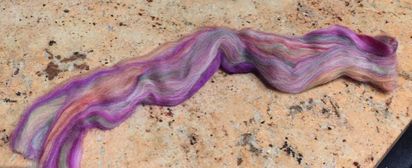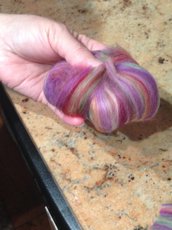 Several months ago, I was busy working on making soap for Tailored Touches orders when Callie, my ever-curious assistant, asked me what “felting” was and why I had decided to offer felted soap as a product. As I explained the process to her, she became just as intrigued in the technique as I had when I first tried it. Needless to say, we stopped what we were doing, pulled out some cured buttermilk soap and roving wool, and started felting! She got totally into it. We had a blast!
Callie's Questions on Felt!Callie had a million questions! Here are some of them... 1 – What is felt? Felt is a dense fabric made with natural wool fibers. By wetting the fibers with hot water and rolling, pressing, or agitating them with soap, the fibers all become interlocked and matted together permanently. This process has been used for at least 5500 years. It is resistant to wind and water, making felt an excellent choice for clothing in the colder climates. The Greeks taught the Romans how to felt. The Vikings passed their knowledge down to the people living in the British Isles. Because it is a natural fabric, much of the early examples of felt have decomposed over the centuries... but not all! In fact, one of the earliest felted garments found was in Coventry, England and traced to the 13th century! 2 – Do you have to use wool fibers? Can’t you use a plant fiber to make felt? Animal fibers will intertwine into felt, but plant fibers will not. So, felt is only made of animal fibers, most notably wool. You can use other types of animal fibers, but they can be more difficult to find or prohibitively expensive. So, wool is the most common fiber found in most any felt. 3 – What is “roving wool," and why is it a good choice for felted soap? Roving wool is a type of wool that has long fibers. This makes wrapping up the soap easier. In order to make a felted soap, you need to wrap up a bar or ball of soap much like a gift and then work it under very hot water. 4 – Why use felted soap instead of regular soap? Long before people used loofahs or washcloths for bathing, felted soap allowed you to get a creamy lather without using much soap and gave you a built-in washcloth. The felting helps to conserve the bar of soap so it lasts longer... plus the wool is anti-bacterial! The roughness of the wool acts as an exfoliant by removing dull, dead skin cells to expose new ones. This is great for the skin. So, felted soap is a practical, yet beautiful, way of getting clean! 5 – Uh oh. What do I do when the soap is all used up? If you are like me, you can’t ever throw away the last little sliver of soap! So, I usually just paste it onto the next new bar. With felted soap, you can always recycle by cutting a small slit into the felt and stuffing slivers of soap inside. That way, you don’t waste any soap slivers, and you can make your own felted soap!
4 Comments
Priscilla
10/16/2019 09:50:13 am
Where do you find packaging for the soap? Wanting something unique around the soap any ideas what do you use ?
Reply
Melissa
11/5/2019 08:05:13 pm
Hi Priscilla! I just use a ribbon to tie on a tag with the ingredients and use instructions for this felted soap. It gives folks a chance to feel the wool and sniff the soap. You could use a cigar band printed with your product name, ingredients, and instructions or find a clear box that fits your soap. Hope that helps!
Reply
Leave a Reply. |
Welcome to Tailored Tidbits!If I'm not in the kitchen cooking up new items for my shop, I'm sewing fabric baskets, taking care of our honeybees, pitching in on the latest project at my son's, or planning a trip somewhere with my daughter. Here, I'll share a "day in the life" at Tailored Touches! 
Sign up for the newsletter for an instant 10% off coupon.
Categories
All
Archives
February 2019
|





 RSS Feed
RSS Feed


